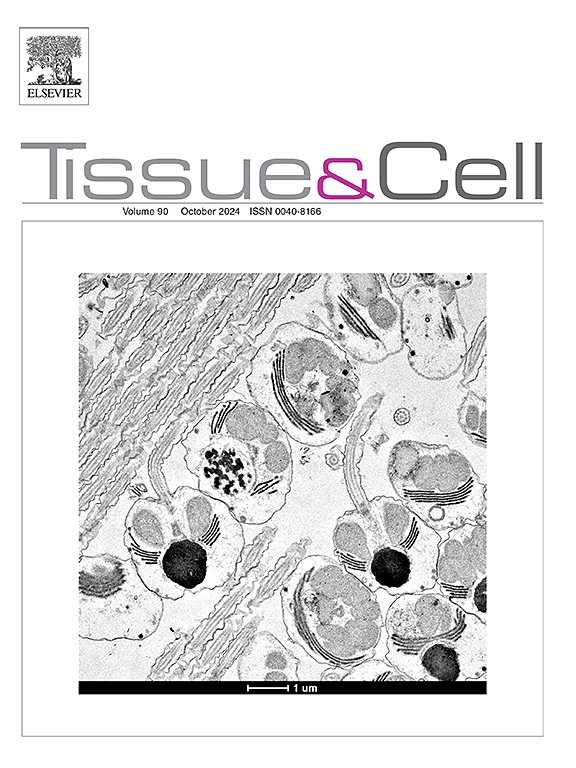一种通过CRISPR/Cas9插入人类端粒酶逆转录酶单拷贝来永生化人原代CD8+ T细胞的新方法
IF 2.7
4区 生物学
Q1 ANATOMY & MORPHOLOGY
引用次数: 0
摘要
现有的细胞永生化方法使细胞获得致癌表型和/或导致细胞获得和/或失去染色体。永生化正常人类T细胞系为基础研究和治疗产品开发提供了重要的体外模型。方法利用CRISPR/Cas9系统,用人类端粒酶逆转录酶(hTERT)单拷贝替换细胞周期抑制基因CDKN2A(编码p16和p14蛋白)的外显子2,使人原代CD8+T细胞(hCD8+T- tert)永生化。结果利用Cas9蛋白和低供体DNA拷贝数/细胞,成功实现了hCD8+T细胞的单拷贝永活,避免了Cas9基因和引导RNA载体的不可控插入。来自独立供体的人原代CD8+细胞被永生化并扩增超过2.6 × 107倍。对其中一株CD8+ T-TERT永生化细胞系的表征显示,细胞保留了大部分细胞表面标记和正常核型。CD8+ T-TERT细胞也保留了IL-2和CD3/CD28激活剂的生存和扩增依赖性。结论采用新方法建立了稳定的永生化细胞系,且永生化CD8+ T细胞具有与T细胞一致的表型。本文章由计算机程序翻译,如有差异,请以英文原文为准。
A novel immortalization method for immortalizing human primary CD8+ T cells by inserting a single copy of human telomerase reverse transcriptase via CRISPR/Cas9
Background
Existing cell immortalization methods made the cells obtain oncogenesis phenotype and/or caused the cells gain and/or lose chromosomes. Immortalized normal human T cells lines provide critical in vitro models for basic research and therapeutic products development.
Methods
We developed a novel method utilizing a CRISPR/Cas9 system to replace the exon 2 of the cell cycle inhibitor gene CDKN2A (encoding p16 and p14 proteins) with a single copy of human telomerase reverse transcriptase (hTERT) to immortalize human primary CD8+ T cells (hCD8+T-TERT).
Results
By using Cas9 protein and low donor DNA copies/cell, we successfully immortalized hCD8+T cells with a single copy of hTERT transgene, which also avoided uncontrolled insertion of Cas9 gene and guide RNA vector. Human primary CD8+ cells from independent donors were immortalized and expanded more than 2.6 × 107 times. Characterization of one of the immortalized CD8+ T-TERT cell lines revealed that the cells retained most of the cell surface markers and normal karyotype. The CD8+ T-TERT cells also retained the dependence of IL-2 and CD3/CD28 activator for survival and expansion.
Conclusion
We established a stable immortalized cell lines using the novel immortalization method, and the immortalized CD8+ T cells had a phenotype consistent with T cells.
求助全文
通过发布文献求助,成功后即可免费获取论文全文。
去求助
来源期刊

Tissue & cell
医学-解剖学与形态学
CiteScore
3.90
自引率
0.00%
发文量
234
期刊介绍:
Tissue and Cell is devoted to original research on the organization of cells, subcellular and extracellular components at all levels, including the grouping and interrelations of cells in tissues and organs. The journal encourages submission of ultrastructural studies that provide novel insights into structure, function and physiology of cells and tissues, in health and disease. Bioengineering and stem cells studies focused on the description of morphological and/or histological data are also welcomed.
Studies investigating the effect of compounds and/or substances on structure of cells and tissues are generally outside the scope of this journal. For consideration, studies should contain a clear rationale on the use of (a) given substance(s), have a compelling morphological and structural focus and present novel incremental findings from previous literature.
 求助内容:
求助内容: 应助结果提醒方式:
应助结果提醒方式:


